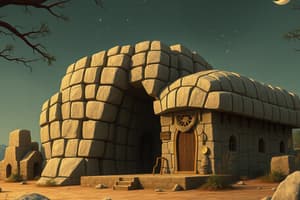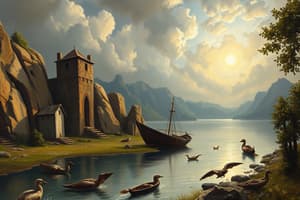Podcast
Questions and Answers
The Prehistoric period was defined as a period of man's history that was not recorded, lasting from 250KYA to ______ years ago.
The Prehistoric period was defined as a period of man's history that was not recorded, lasting from 250KYA to ______ years ago.
3KYA
The Stone Age refers to the period from around 250KYA to ______ years ago.
The Stone Age refers to the period from around 250KYA to ______ years ago.
5KYA
The Bronze Age, lasting from 5KYA to ______ years ago, saw the discovery of bronze, an alloy of copper and tin.
The Bronze Age, lasting from 5KYA to ______ years ago, saw the discovery of bronze, an alloy of copper and tin.
3300
The Iron Age began around ______ years ago with the discovery of iron-making techniques.
The Iron Age began around ______ years ago with the discovery of iron-making techniques.
The Paleolithic period lasted from 250KYA to ______ years ago.
The Paleolithic period lasted from 250KYA to ______ years ago.
During the Paleolithic period, humans discovered ______ and cooked their large prey.
During the Paleolithic period, humans discovered ______ and cooked their large prey.
The Mesolithic period lasted from ______ to 10KYA, characterized by more sophisticated stone tools.
The Mesolithic period lasted from ______ to 10KYA, characterized by more sophisticated stone tools.
Many prehistoric peoples began to establish permanent ______ towards the end of the Mesolithic period.
Many prehistoric peoples began to establish permanent ______ towards the end of the Mesolithic period.
Humans in the Paleolithic period lived in caves, huts, and ______.
Humans in the Paleolithic period lived in caves, huts, and ______.
The end of the Paleolithic saw the extinction of many large mammals, including the wooly ______.
The end of the Paleolithic saw the extinction of many large mammals, including the wooly ______.
Study Notes
Prehistoric Period Overview
- Lasted from approximately 250,000 years ago (KYA) to 3,000 years ago (YA) and signifies eras without recorded history.
- Divided into three major ages: Stone Age, Bronze Age, and Iron Age.
Stone Age (250KYA to 5KYA)
- Characterized by the use of stone tools for various purposes, including hunting, gathering, agriculture, and art.
- Marked the transition from nomadic hunting-gathering societies to settled agricultural communities.
Stone Age Subdivisions
-
Paleolithic Period (250KYA to 12KYA)
- Inhabitation of caves, huts, and teepees; reliance on hunting and gathering.
- Development of basic stone and bone tools, discovery of fire for cooking.
- Extinction of large mammals, like woolly mammoths, during the last ice age.
- Engagement in early forms of art, such as cave paintings and small sculptures.
-
Mesolithic Period (12KYA to 10KYA)
- Introduction of more sophisticated, polished stone tools, often combined with bone and wood.
- Nomadic lifestyle persisted, with communities moving in search of resources near water bodies.
- Towards the end, some groups began establishing permanent settlements and adopting agriculture.
-
Neolithic Period (10KYA to 5KYA)
- Shift from nomadic lifestyles to permanent settlements facilitated by advancements in agriculture and animal domestication.
- Introduction of innovative tools like polished hand axes and bladed plows, improving food production.
- Rise of larger and more complex social structures, leading to the formation of villages, towns, and eventually cities such as Eridu, Uruk, and Ur in ancient Mesopotamia.
Bronze Age (5KYA to 3300YA)
- Emergence of bronze, an alloy of copper and tin, which led to significant technological advancements.
- Invention of the ox-driven plow and the wheel, enhancing agricultural productivity and efficiency.
- Development of organized government, legal systems, military strategies, and organized religion.
Iron Age (3300YA to 2900YA)
- Introduction and widespread use of iron, a more readily obtainable resource than bronze.
- Advancements in tools and architecture, including the construction of grand palaces and temples.
- Development of early city planning and the advent of writing systems, signifying the beginning of documented history.
Studying That Suits You
Use AI to generate personalized quizzes and flashcards to suit your learning preferences.
Description
Explore the fascinating eras of human history known as the Prehistoric period. This quiz covers the three main divisions: the Stone Age, Bronze Age, and Iron Age, highlighting key transformations in tool use and societal development. Test your knowledge of these significant historical phases!




